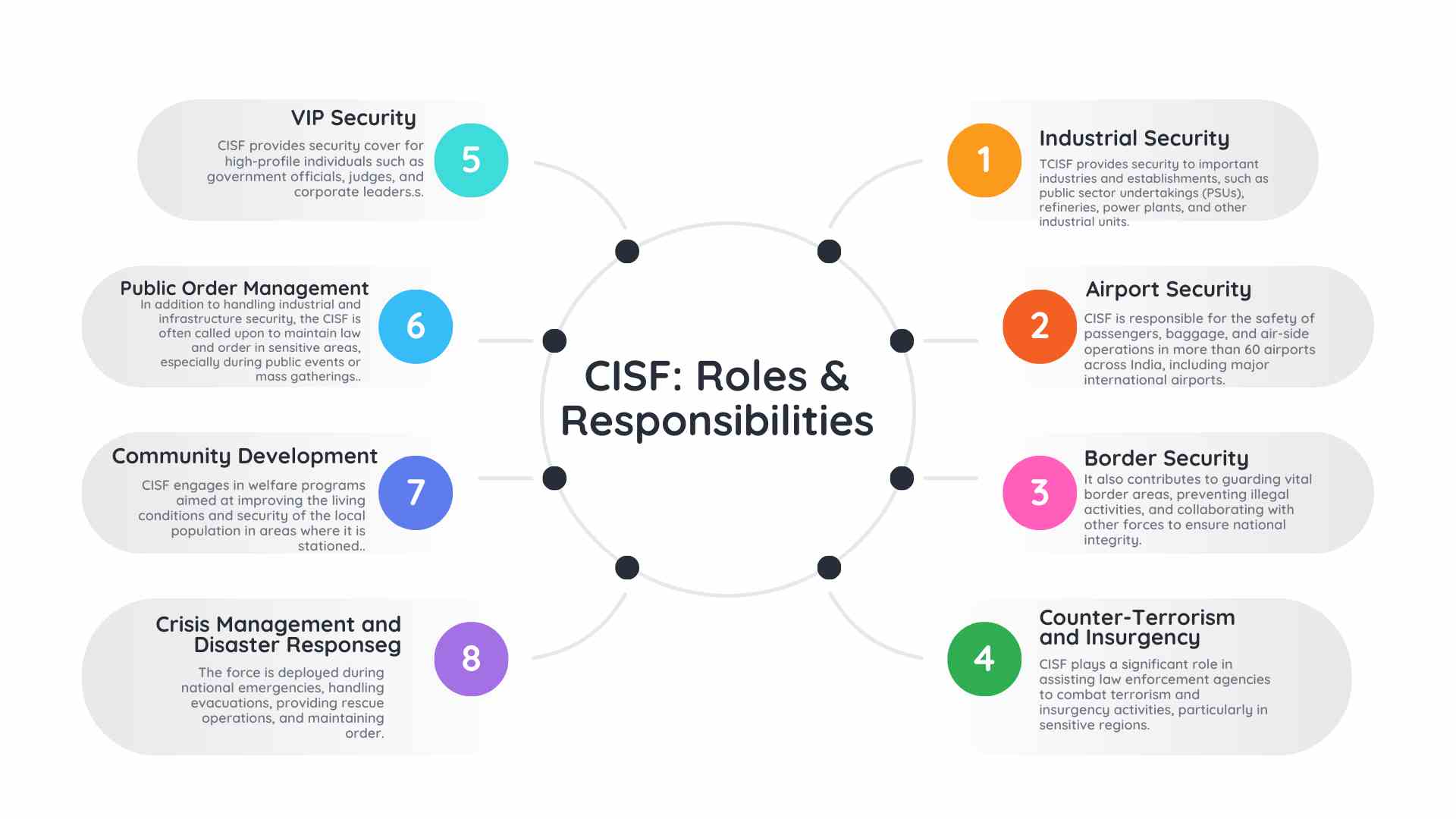Key Points
- Established on March 10, 1969, under the Ministry of Home Affairs.
- Secures vital infrastructure like airports, seaports, and PSUs.
- Conducts CISF Constable, Head Constable, and ASI exams.
The Central Industrial Security Force (CISF), as the name suggests, is a paramilitary force tasked with providing security to industrial areas, public sector undertakings, airports, and other critical infrastructure across India. Established under the Ministry of Home Affairs, Government of India, CISF plays a vital role in safeguarding industries, managing law and order in sensitive areas, and offering protection to vital national assets. Read this article to know more about CISF's full form, its history, roles, recruitment process, and other key aspects.
CISF Full Form: Central Industrial Security Force
The Central Industrial Security Force (CISF) was established in 1969 with the aim of securing key industrial locations and critical infrastructure throughout India. The CISF is one of the major forces under the Ministry of Home Affairs, primarily tasked with ensuring the safety and protection of public sector undertakings (PSUs), airports, seaports, and various high-risk industrial installations. The force is also responsible for providing security cover to high-profile individuals, handling crisis situations, and assisting in national emergencies.
CISF Full Form: Overview
| Category | Details |
| Full Form | Central Industrial Security Force (CISF) |
| Date of Establishment | March 10, 1969 |
| Ministry | Ministry of Home Affairs, Government of India |
| Current Director General | Shri Sheel Vardhan Singh |
| Parent Organization | Central Armed Police Forces (CAPF) |
| Motto | Protection and Security |
| Strength | Approximately 1.6 Lakh personnel |
| CISF Exams | CISF Constable, CISF Head Constable, CISF ASI |
| Website |
CISF: History & Formation
The Central Industrial Security Force (CISF) was created on March 10, 1969, to provide industrial security to public sector undertakings (PSUs) in India. Its establishment came as a response to the rising need for securing industries due to increased threats to national assets. Initially, it was formed with a small strength, primarily focused on guarding industrial plants and factories.
Over the years, its scope of work expanded to include providing security for sensitive establishments, critical infrastructure such as airports, seaports, and metro stations, and offering protection during national emergencies. In 1983, the CISF was officially empowered by the Indian Parliament to offer security cover to nuclear installations and critical national assets.
CISF Examinations: CISF Constable, CISF Head Constable, CISF ASI
CISF recruits personnel through various exams for positions like Constable, Head Constable, and Assistant Sub-Inspector (ASI). Below is an overview of some key exams:
- CISF Constable: The CISF Constable exam is designed for candidates who will be responsible for security duties in industrial and high-risk areas. The examination is computer-based and comprises multiple-choice questions.
- CISF Head Constable (HC): Candidates for the position of Head Constables in the CISF are typically involved in administrative and clerical work. The exam tests candidates on general awareness, reasoning ability, and numerical aptitude.
- CISF Assistant Sub-Inspector (ASI): The CISF ASI exam is held for selecting candidates who will oversee security operations, maintain law and order, and handle coordination in industrial security settings.
CISF Posts: Ranks
| Category | Rank |
| Non-Gazetted Officers (NGOs) | Constable (OR) |
| Head Constable (HC) | |
| Subordinate Officers (SOs) | Assistant Sub-Inspector (ASI) |
| Sub-Inspector (SI) | |
| Inspector | |
| Gazetted Officers (GOs) | Assistant Commandant (AC) |
| Deputy Commandant (DC) | |
| Commandant (C) | |
| Deputy Inspector General (DIG) | |
| Inspector General (IG) | |
| Additional Director General (ADG) | |
| Director General (DG) |
CISF Symbol and Motto: Meaning of CISF Emblem
The CISF symbol includes a combination of powerful elements that represent strength, protection, and security:
- Crossed Swords: Symbolize strength and preparedness for any threat.
- Shield: Represents defense, security, and the protection of vital assets.
- Torch: A beacon of knowledge and wisdom, guiding the way.
- Olive Branches: Represent peace, harmony, and dedication to service.
- Tricolour Stripes: Reflect India’s national flag, symbolizing patriotism.
The motto of the Central Industrial Security Force (CISF) is "Protection and Security", signifying its role in safeguarding industrial infrastructure and national assets.
CISF: Roles and Responsibilities
The CISF is responsible for a wide array of tasks that directly contribute to the security and safety of India’s critical infrastructure:

- Industrial Security: CISF provides security to important industries and establishments, such as public sector undertakings (PSUs), refineries, power plants, and other industrial units.
- Airport Security: CISF is responsible for the safety of passengers, baggage, and air-side operations in more than 60 airports across India, including major international airports.
- Border Security: It also contributes to guarding vital border areas, preventing illegal activities, and collaborating with other forces to ensure national integrity.
- Counter-Terrorism and Insurgency: CISF plays a significant role in assisting law enforcement agencies to combat terrorism and insurgency activities, particularly in sensitive regions.
- Crisis Management and Disaster Response: The force is deployed during national emergencies, handling evacuations, providing rescue operations, and maintaining order.
- VIP Security: CISF provides security cover for high-profile individuals such as government officials, judges, and corporate leaders.
- Public Order Management: In addition to handling industrial and infrastructure security, the CISF is often called upon to maintain law and order in sensitive areas, especially during public events or mass gatherings.
- Community Development: CISF engages in welfare programs aimed at improving the living conditions and security of the local population in areas where it is stationed.
CISF: Designated Zones
The CISF operates in various zones across the country to ensure comprehensive coverage of national infrastructure. These zones are as follows:
- Central Zone
- J&K Zone
- North Eastern Zone
- Southern Zone
Each zone manages security responsibilities in designated regions, ensuring efficient coordination across India’s industrial and critical infrastructure.
Also Look For:
Comments
All Comments (0)
Join the conversation